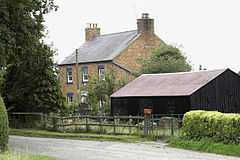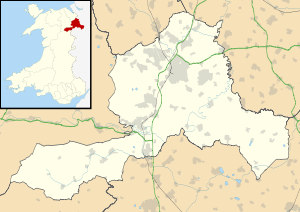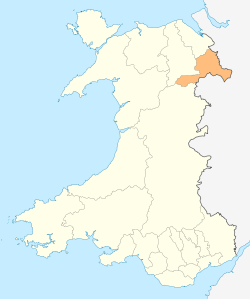Arowry
| Arowry | |
 Top House Farm, Arowry |
|
 Arowry |
|
| OS grid reference | SJ457390 |
|---|---|
| Community | Hanmer |
| Principal area | Wrexham |
| Ceremonial county | Clwyd |
| Country | Wales |
| Sovereign state | United Kingdom |
| Post town | WHITCHURCH |
| Postcode district | SY13 |
| Police | North Wales |
| Fire | North Wales |
| Ambulance | Welsh |
| EU Parliament | Wales |
| UK Parliament | Clwyd South |
| Welsh Assembly | Clwyd South |
Coordinates: 52°56′48″N 2°48′33″W / 52.94653°N 2.80908°W
Arowry (Welsh: Yr Owredd) is a small village in the community of Hanmer in the rural south-east of Wrexham county borough, Wales, near the border with England. The origin of its name is unclear but is thought to have a Welsh-language root.[1] It has also been referred to as "Big Arowry", or "Great Arowry", in order to distinguish it from the hamlet of Little Arowry around a mile to the north near Horseman's Green.
Alfred Palmer, the Wrexham historian, noted that the area called Arowry, before enclosure, was a "great heath" sometimes given the Welsh name "Yr owredd", and colloquially referred to as "the Rowrey", or "the Arowry".[2] Thomas Gwynn Jones suggested that the name Owredd was originally derived from a Welsh pronunciation of the English name "Overheath".[3]
The nineteenth-century philologist Alexander John Ellis studied the dialect of a native of Arowry, John Heatley, as part of his work, published in On Early English Pronunciation, on English dialects. The unusual dialect of the Hanmer area was later studied in the Survey of English Dialects.
The village is near the A539 road and is 10 kilometres (6 mi) west of the nearest major town, Whitchurch in Shropshire.
References
- ↑ Maelor Saesneg, Clwyd-Powys Archaeological Trust.
- ↑ Palmer, A. N. A History of Ancient Tenures of Land in North Wales and the Marches, 1910, p.247
- ↑ T. Gwynn Jones, Gwaith Tudur Aled, v.II Cardiff, 1926, p. 589
| ||||||||||||||||||||||||||||||||||||
